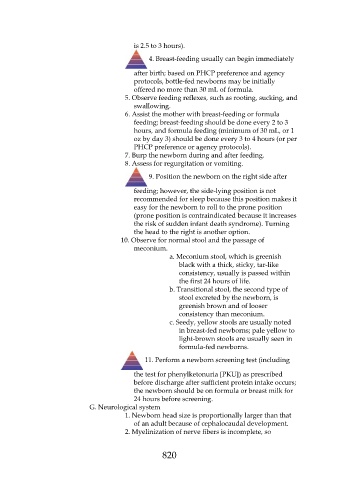Page 820 - Saunders Comprehensive Review For NCLEX-RN
P. 820
is 2.5 to 3 hours).
4. Breast-feeding usually can begin immediately
after birth; based on PHCP preference and agency
protocols, bottle-fed newborns may be initially
offered no more than 30 mL of formula.
5. Observe feeding reflexes, such as rooting, sucking, and
swallowing.
6. Assist the mother with breast-feeding or formula
feeding; breast-feeding should be done every 2 to 3
hours, and formula feeding (minimum of 30 mL, or 1
oz by day 3) should be done every 3 to 4 hours (or per
PHCP preference or agency protocols).
7. Burp the newborn during and after feeding.
8. Assess for regurgitation or vomiting.
9. Position the newborn on the right side after
feeding; however, the side-lying position is not
recommended for sleep because this position makes it
easy for the newborn to roll to the prone position
(prone position is contraindicated because it increases
the risk of sudden infant death syndrome). Turning
the head to the right is another option.
10. Observe for normal stool and the passage of
meconium.
a. Meconium stool, which is greenish
black with a thick, sticky, tar-like
consistency, usually is passed within
the first 24 hours of life.
b. Transitional stool, the second type of
stool excreted by the newborn, is
greenish brown and of looser
consistency than meconium.
c. Seedy, yellow stools are usually noted
in breast-fed newborns; pale yellow to
light-brown stools are usually seen in
formula-fed newborns.
11. Perform a newborn screening test (including
the test for phenylketonuria [PKU]) as prescribed
before discharge after sufficient protein intake occurs;
the newborn should be on formula or breast milk for
24 hours before screening.
G. Neurological system
1. Newborn head size is proportionally larger than that
of an adult because of cephalocaudal development.
2. Myelinization of nerve fibers is incomplete, so
820

